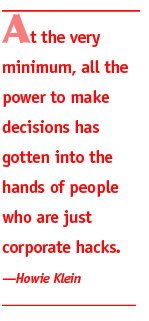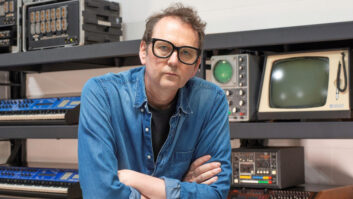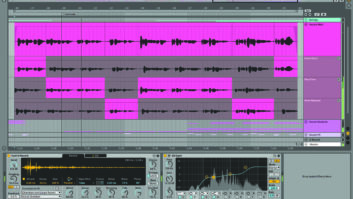
It was the late, great Nashville engineer Denny Purcell who, in a moment of frustration and resignation, opined about the audio industry, “We live in the age of ‘good enough.’”
Indeed, many people today argue that despite the better efforts of so many throughout our industry, there has been a decline in the quality of recordings, of equipment and of the overall music business climate. Music listeners are settling for mediocrity instead of insisting on excellence. Convenience always seems to trump fidelity.
As with the music industry doomsday scenarios of two years ago, the carping and kvetching about quality is not without some justification — but neither is it a true crisis, nor even a radical departure from historical precedent.
One reason things look so bleak to so many in our field is that to a large degree, much of what we do is an adjunct to the record business, and that industry has been going through strange and depressing times for at least a decade, with no end in sight. As the major labels have become consolidated as part of larger corporate entities unconcerned about the “art” of music, instead interested only in generating profits for über-companies’ stockholders, label rosters have been decimated, recording budgets have been dramatically slashed and there has been a serious negative trickle-down effect that has eaten away at recording studio profits and, by extension, audio equipment manufacturers. The lengthy studio lockout is virtually a thing of the past; indeed, rare is the project now that is fully recorded and mixed in a single facility. Record companies know that studios are struggling to find business and are forcing recording rates to go lower and demanding that projects be completed more quickly, quality be damned. Indie labels have taken up some of the slack, but they are in no position to be the sort of free-spenders that the majors were from the late 1960s until the early ’90s.
Recently, I called up an old record biz colleague of mine, Howie Klein, to ask him about the deterioration of the record business. A one-time music journalist, Klein’s industry credentials include founding the fine San Francisco Bay Area-based new-wave label 415 records (Romeo Void, Translator, et al) and stints as president of both Warner/Sire and Reprise Records. Now, he’s semi-retired, teaching occasionally at McGill University and still working with young bands when the inspiration strikes. What, I asked him, is the cause of the record industry’s malaise?
“In one word, corporatization. I don’t believe the corporate form of organizing business can work with art. It was just a matter of time before the entrepreneurs who got the modern record business going — Mo Ostin and Ahmet Ertegun and others — were going to be superseded for one reason or another — and age was a certainly a factor — by people who weren’t music-loving visionaries but who were basically corporate hacks. That’s not to say that everyone in the music business is a corporate hack. But at the very minimum, the power to make decisions has gotten into the hands of people who are just corporate hacks.” In other words, he says, the power migrated from the divisional level of the record companies when giant corporations bought those companies. “The power was gradually taken over by the corporate owners. It was disastrous for the artists, the employees, music in general. Aside from a few guys at the top who made tens to hundreds of millions of dollars, everyone else was the loser.”
How does the corporate climate filter down to the labels? Klein says that at least in rock music, he believes the most successful model is to find artists whose musical vision you believe in and to support them. “They don’t break on the first album. Occasionally they do — you find an Alanis Morrisette who comes along and sells 23 million copies of her first record. Much more common would be something like Depeche Mode or Barenaked Ladies, two bands I worked with, where it takes five records before they break.” Klein notes that in the case of those two bands, their eventual success led to Platinum sales for earlier albums that had not been successful, but in the current climate, the only thing that matters is breaking bands immediately to improve quarterly profits.
“The other more insidious thing that’s happening is that the music people are slowly disappearing and being replaced by business people,” he continues. “When I was chosen to be president [of Sire], I was chosen because I was thought of as an artist’s guy, but then once I was president, my job had nothing to do with that. I was supposed to figure out budgets; I was like an accountant. They would ask me, ‘Okay, how many copies are we going to sell of the next Ministry album?’ ‘How the f*** do I know? The band didn’t even write the songs yet!’ But they literally based everything on how many they’re going to sell. With Alanis and Jagged Little Pill, we figured she was going to sell 25,000 and she sold 23 million. Doesn’t that tell you the system is idiotic? When I felt it reached a point where it was irrevocable, I retired.”
From a sonic standpoint, the development that has audio-conscious types fretting is the continued proliferation — explosion, really — of MP3s as the medium of choice for so many music lovers. It was bad enough when x-thousand people were downloading “shared” MP3 files for free through pirate sites all over the Internet. But with the success of Apple’s iTunes and iPod (AAC encoding), and similar ventures by other companies, the supposedly inferior technology (as compared to CD) has been embraced and legitimized by the music industry. Add into the equation that many people are listening to MP3s on either tiny “ear buds” or inferior computer speakers, and it’s easy to understand why audio engineers and others sometimes wonder, “Why am I slaving long hours in the studio trying to make pristine recordings?”
But step back for a second and take the long view. As Crosby, Stills & Nash sang in “Déjà Vu,” “We have all been here before.” I hold in my hand, exhibit A. This quaint piece of plastic casing with some flimsy tape on small spools is called a cassette. There was a time not so long ago when engineers complained about the comparatively horrible sound of cassettes; unquestionably, they were inferior to LPs. Some even argue that the quality drop-off between LPs and cassettes was greater than from CD to MP3. Eventually, cassette sales eclipsed album sales, even though everyone knew they didn’t sound as good. Why? Convenience, of course. Cassettes gave us music on-the-go — for cars, Walkmen (okay, “personal stereos”) and large and small boom boxes.
But you know what? It didn’t change the music one iota. There isn’t a single engineer who settled for inferior recordings because the ultimate destination for many music listeners was going to be a shitty-sounding cassette played through mediocre car speakers or a $49 “blaster.”
The sad fact is, beyond the issue of cassette quality, most people did not have very good home hi-fi systems to listen to LPs either. In the ’70s, I had audiophile aspirations but not the budget to match, so I lugged a decent Garrard turntable, KLH bookshelf speakers and a Panasonic amp around to my many domiciles. Most people I knew had worse systems than I did, but we all actually cared about music and spent hours sitting around intently listening to albums — an increasingly rare practice. In a way, CDs leveled the playing field somewhat — they sounded better on mediocre systems than LPs did — and today, even the worst low-budget setups are much better than comparable ones from the LP age. Still, if iTunes and CDs through computer speakers is “good enough,” it is in part because the majority of the population don’t own top-quality equipment, and they don’t listen to music that seriously to begin with. However, one could argue that the iTunes experience may help listeners to care more about quality because listening to music alone on buds or ‘phones is an intimate act that bonds the musician and listener.
The good news is that equipment manufacturers and engineers are constantly striving to make better-sounding gear and discs. Millions of dollars (or pounds or yen) have been poured into R&D and marketing, and the result is a constantly evolving technological landscape. Multimillion-dollar busts have occurred along the way — remember DCC, the ill-fated digital cassette? — as well as important trends that changed the way people worked and permanently altered the economics of the industry. Those ADATs you have in the closet probably aren’t getting much use now that you’ve got your Pro Tools rig, but they might have kept you afloat during tough times, and they served as a bridge to today’s digital workstation ubiquity.
Now the buzz — and the R&D money — are going to high bit rate and surround formats. Engineers and producers and record companies are psyched. But the public is confused. SACD or DVD-A? DVD-V? Dual-layer? Surround for hi-def television? 5.1? 6.0? What the hell is 7.1? Those of us in the industry are in a rarified position, having been indoctrinated to this exciting new wave of products and approaches through the years. I’ve often thought that if every person in America had the chance to sit in the sweet spot in a first-rate control room and listen to the surround version of The Eagles’ “Seven Bridges Road,” surround would catch on in a week! But the reality is that MP3 is “good enough” for the casual music fan and besides, “Where the hell am I going to put the rear speakers, center channel and subwoofer of the 5.1 system in my tiny apartment?”
“I think people are a little wary of the new formats,” comments mastering legend Bernie Grundman. “At this point, I’m mainly hoping that people will still support normal CDs because the quality is so much better than [MP3]. I would hope that when people sit down and really give a serious listen to something, they would expect higher quality, but that may not be the case.” Grundman is afraid that new, high-res formats won’t survive. “They’re popular with the audiophiles, but that’s probably not going to be enough,” he says. “So far, for whatever reason, the public doesn’t seem to be going for a high-resolution audio-only disc. It seems as though people want video, too, so the DVD-V is more likely to stick around. Unfortunately, quality does not always win out.”
Grundman works with every kind of recording imaginable, and while he believes that “a lot of effort is going into improving equipment all the time,” other considerations affect the quality of the music. “One of the gross areas is level,” he says. “To get their records noticed, people want them to be louder than the next guy’s, and to get level, there’s a lot of processing that goes on. The by-product of that is a form of distortion. It usually isn’t blatant [distortion], but it doesn’t sound natural and it sounds less musical; it sounds almost mechanical.
“In pop music especially, it’s gone to a mid-fi kind of sound. I’m finding that a lot of the newer engineers are kind of intoxicated with technology; they’re not as aware of the actual quality of the sound as they are in how they can manipulate it in the computers with all the plug-ins. Sometimes, their judgment gets thrown off because they’ve bought into the notion that in the digital domain, you can do a lot of manipulation and you won’t degrade the sound, which is entirely wrong. My rule of thumb is, anything you do to the signal, any plug-in you put in, you’re degrading the signal somewhat. So then the question becomes, what really needs to be part of this track? By adding this and this, are you gaining more than you’re losing? I have my own preferences, but on a pop or rap track, maybe those plug-ins and gimmicks are what the track needs to get attention. So then it’s more a matter of marketing than music, maybe, but who’s to say one is better than the other? Obviously, there’s no single answer to what ‘quality’ is in a recording.”
The “quality” question spills over into every area of audio, from the training that up-and-coming engineers are getting in schools, to the products that are being promoted by retail stores and e-commerce sites, to the impact of diminishing recording budgets and concomitant rise of personal recording spaces. How has the live sound industry been affected by these factors? Are engineers being asked to do more with less? Have “prosumer” and “professional” merged for good? Join Mix‘s editors for an in-depth look at these issues and how the best in our industry are dealing with them in this era of lowered expectations and revenues the only way they know how — by refusing to give in to complacency and continuing to raise “quality” ever higher.
Blair Jackson is Mix’s senior editor.







